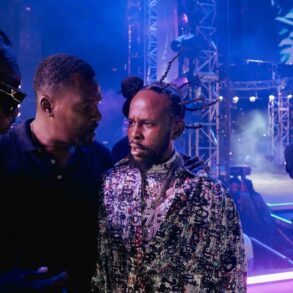“It’s all starting to cross-pollinate down here,” said Amy Denet Deal, the brainchild behind the Indigenous Futures 4Ever fashion show held at the Santa Fe Railyard on Saturday night, where CFDA interim member Josh Tafoya and other performers and designers from the Southwestern U.S., Canada and Mexico represented the best of the global Indigenous arts movement.
With a blend of runway, Native American hoop dance, hip-hop and spoken word, the joyful happening could offer a lesson or two to fashion show producers. The performers —Tia Wood, singing her single “Dirt Road” about being a Cree singer finding her way in L.A.; climate activist and hip-hop singer Xiuhtezcati Martinez rapping with “Reservation Dogs’” composer Mato Wayuhi, and First Nations hip-hop group Snotty Nose Rez Kids dropping new music — were seamlessly integrated into the runway show as models as well.
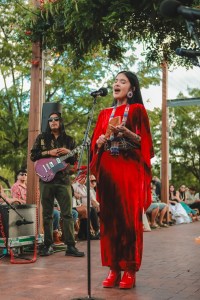
Tia Wood
Courtesy of Nate Lemuel from Darklisted Photography
The event was smack in the middle of the Southwest Association for American Indian Arts’ 102nd Indian Market, held annually around the Plaza in Santa Fe, N.M., which has its own well-established contemporary Indigenousfashion runway show and event.
You May Also Like
But Denet Deal, whose 4Kinship store has been a platform for emerging Native designers, wanted to create an alternative fashion festival and block party. Build Native by Shopify and Pinterest came on to sponsor, and honorariums were paid to all the participants.
“SWAIA will always be a part of the heritage of Santa Fe, because they have been here 102 years, but there are a lot of new things happening here. It’s almost turning into a South by Southwest vibe, and my events are based on that next gen,” said Denet Deal, who was adopted by a white family at birth and lived for decades not knowing about her Diné heritage. After discovering it later in life, she pivoted from a career in corporate fashion to reconnect with her roots, opening 4Kinship to uplift and sell Native fashion designers, and her own distinctive line of hand-dyed upcycled military garb and vintage.
Multicultural identity was a central theme for the designers and performers who participated at Saturday’s event, including rising fashion star Tafoya.
The designer from Taos, N.M., presented his second collection, which was inspired by his complicated identity. “The collection is about my family history, delving into the idea of Genizaro,” he said, referring to the name of detribalized Native Americans from the 17th to 19th centuries in the Spanish colony of New Mexico and neighboring regions of the American Southwest.
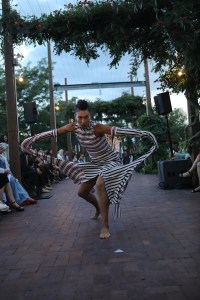
Josh Tafoya
Courtesy of Nate Lemuel from Darklisted Photography
It started with commercially minded, buttoned-up looks, such as a chic mariner stripe knit maxidress with waist ties that could be worn as long sleeves, and a striped denim shirtdress, before moving into more of a punk rock vibe with a fraying cream woven biker jacket and cargo shorts with holes cut out of the fronts, and subtle blanket-stripe slashed separates. Tafoya ended with a series of incredible, sculptural ponchos constructed of overlapping riotously patterned woven layers, feathers and fringe that should be in a museum.
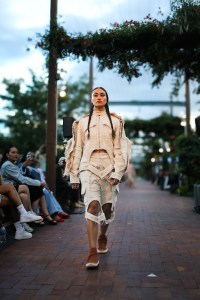
Josh Tafoya
Courtesy of Nate Lemuel from Darklisted Photography
“It goes back to the Native Spanish slave trade when it was New Spain, then creating mixed bloods, the transition when Mexico took over, and then the United States took over, and then this moment of reclaiming,” Tafoya said of his history. “The collection started in a clean-cut, more pre-colonial sense…going into deconstruction, raw edge, folding, all these things that are like ‘what the f–k is my culture?’ It’s such a dark history but the collection shows itself as a party, trying to reclaim our history, identity, and our Indigenous sense.”
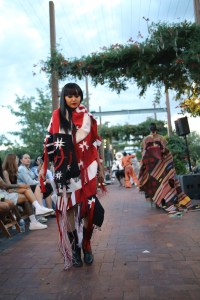
Josh Tafoya
Courtesy of Nate Lemuel from Darklisted Photography
Another message of the show was cross-border allyship, as seen by the representation of Indigenous designers from the south (Mexico City-based Carla Fernández works with artisanal groups all over Mexico to produce her spectacular collections) and north (a group of designers from Vancouver Fashion Week came to show in Santa Fe). The coming together was an acknowledgment of the impact of colonial borders on Indigenous groups globally.
Denet Deal brought Fernández’ work to the runway after seeing it at the Santa Fe International Folk Art Market a few weeks ago. “She couldn’t come back to Santa Fe, so we styled it all. I’m talking to them about doing a fashion show for the IFA market, too. It’s all growing,” she said of the fashion scene.
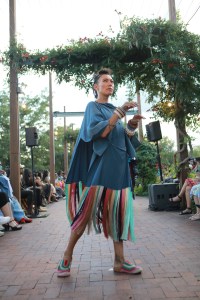
Carla Fernández
Courtesy of Nate Lemuel from Darklisted Photography
“I hope more people do shows like this. It’s nice to break the wall and experiment a little bit,” said designer Alejandro Gutierrez, who grew up in Yucatan, Mexico. His Graziano and Gutierrez collection based in Portland, Ore., mixes textiles from Chiapas and Oaxaca with American workwear for its own kind of cross-cultural exchange.
From Vancouver, Canada, Snotty Nose Rez Kids singer Quinton “Yung Trybez” debuted his first streetwear collection, with great-looking wide-leg leather and denim baggy shorts, zip-front jackets, “Stupid Idiot” T-shirts and skeleton-painted Doc Martens.
“We sold every piece,” he said. “I have not been to Santa Fe before, but it was a great experience. And I’m originally from Mexico so it felt good to be closer to home.”
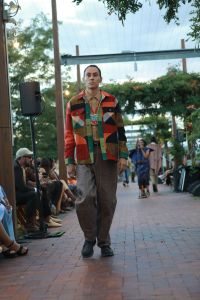
Graziano and Gutierrez
The event at the Railyard featured Native fashion and jewelry pop-ups, food stands and skate demos all weekend, as well as a Snotty Nose Rez Kids merch drop, which people came out for despite the blistering heat.
Entrepreneurship is key to Native communities, said First Nation Kitigan Zibi Anishinabeg member Kyle Brennan Shàwinipinesì, Shopify’s senior lead for Indigenous entrepreneurship, of sponsoring the event. He established the Shopify Build Native platform in 2021, with a digital community resource and storytelling space that counts about 2,000 members. The Build Native platform has helped build brands such as body care line Sister Sage, from person-to-person selling to landing in chain stores.
“I haven’t been able to find statistics for the States, but in Canada, Native folks start businesses at six times the average rate of non-Native folks. That’s partly because when you’ve been ignored or left out of the dominant economic systems for so long, sometimes the only option is to go into business for yourself…Sometimes people start out as crafters or artisans and then they realize OK, I could maybe make this my full-time thing, and there’s a huge Internet international audience for this.”

Savage Kids
On Friday, 4Kinship and Shopify hosted an Indigenous Fashion Summit, where several designers shared their differing experiences as creatives and entrepreneurs, and ideas about embracing a more expansive view of Native design beyond obvious cultural references such as geometric patterns. Like the fashion show, it was livestreamed so kids could watch it all over.
“Representing who I am and where I’m from gives meaning to what I do,” said Tlingit jewelry designer Jennifer Younger, who uses traditional formline design in her gorgeous, modern-looking pieces. “But if I’m selling something it’s for everyone to wear. I wouldn’t sell something that belongs to a clan or is a clan crest…That’s just my own personal way of working.”
It’s not the same for everyone.

4Kinship brand pants and top; Jennifer Younger jewelry
Courtesy of Nate Lemuel from Darklisted Photography
“My brand, Here’s to You, is not Indigenous specific, or specific for one tribe,” said founder Hud Oberly, a Native of Osage, Caddo, and Comanche background living in Brooklyn, where he makes art-inspired casual wear. “It’s about intertwining with today’s artists and convincing people that everyone is creative in some capacity.”
Evolution is a guiding creative force for others.
“We want to represent our cultural heritage, but we also can’t forget to also represent ourselves and who we’ve become,” Graziano and Gutierrez designer Alejandro Gutierrez said at the symposium.
Shopify’s Shàwinipinesì agreed. “It’s important that we not only are trying to recreate what existed in the past but are pushing it forward and allowing it to evolve and change over time. That’s what a living culture is.”
This post was originally published on this site be sure to check out more of their content.





